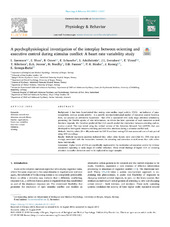| dc.contributor.author | Sørensen, Lin | |
| dc.contributor.author | Wass, Sam Vincent | |
| dc.contributor.author | Osnes, Berge | |
| dc.contributor.author | Schanche, Elisabeth | |
| dc.contributor.author | Adolfsdottir, Steinunn | |
| dc.contributor.author | Svendsen, Julie Lillebostad | |
| dc.contributor.author | Visted, Endre | |
| dc.contributor.author | Eilertsen, Thomas | |
| dc.contributor.author | Jensen, Daniel André | |
| dc.contributor.author | Nordby, Helge | |
| dc.contributor.author | Fasmer, Ole Bernt | |
| dc.contributor.author | Binder, Per-Einar | |
| dc.contributor.author | Koenig, Julian | |
| dc.contributor.author | Sonuga-Barke, Edmund J.S. | |
| dc.date.accessioned | 2020-04-26T14:06:52Z | |
| dc.date.available | 2020-04-26T14:06:52Z | |
| dc.date.issued | 2019-11 | |
| dc.Published | Sørensen L, Wass, Osnes B, Schanche E, Adolfsdottir S, Svendsen JL, Visted E, Eilertsen E, Jensen DA, Nordby H, Fasmer OB, Binder P-E, Koenig J, Sonuga-Barke EJ. A psychophysiological investigation of the interplay between orienting and executive control during stimulus conflict: A heart rate variability study. Physiology and Behavior. 2019;211:112657:1-8 | eng |
| dc.identifier.issn | 0031-9384 | |
| dc.identifier.issn | 1873-507X | |
| dc.identifier.uri | https://hdl.handle.net/1956/21999 | |
| dc.description.abstract | Background It has been hypothesized that resting state cardiac vagal activity (CVA) - an indicator of parasympathetic nervous system activity - is a specific psychophysiological marker of executive control function. Here, we propose an alternative hypothesis - that CVA is associated with early stage attention orientation, promoting the flexible uptake of new information, on which the later operation of such executive control functions depends. We therefore predicted that CVA would predict the interaction between orienting and executive control. This was tested using the revised version of the Attention Network Test (ANT-R) that was developed to distinguish between orienting and executive attention during a stimulus conflict task. Methods Healthy adults (N = 48) performed the ANT-R and their resting CVA was measured over a 5 min period using ECG recordings. Results Multiple regression analyses indicated that, when other factors were controlled for, CVA was more strongly associated with the interaction between the orienting and executive control terms than with either factor individually. Conclusion Higher levels of CVA are specifically implicated in the modulation of executive control by intrinsic orientation operating at early stages of conflict detection. These initial findings of higher CVA on orienting attention in conflict detection need to be replicated in larger samples. | en_US |
| dc.language.iso | eng | eng |
| dc.publisher | Elsevier | eng |
| dc.rights | Attribution CC BY-NC-ND | eng |
| dc.rights.uri | http://creativecommons.org/licenses/by-nc-nd/4.0/ | eng |
| dc.subject | Attention network test | eng |
| dc.subject | Attention network theory | eng |
| dc.subject | Cardiac vagal activity | eng |
| dc.subject | Heart rate variability | eng |
| dc.subject | Executive control | eng |
| dc.subject | Orienting | eng |
| dc.subject | Alerting | eng |
| dc.title | A psychophysiological investigation of the interplay between orienting and executive control during stimulus conflict: A heart rate variability study | eng |
| dc.type | Peer reviewed | |
| dc.type | Journal article | |
| dc.date.updated | 2020-02-04T20:03:49Z | |
| dc.description.version | publishedVersion | |
| dc.rights.holder | Copyright 2019 University of Bergen | eng |
| dc.identifier.doi | https://doi.org/10.1016/j.physbeh.2019.112657 | |
| dc.identifier.cristin | 1744643 | |
| dc.source.journal | Physiology and Behavior | |

